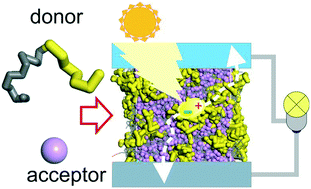Controlling the morphology of a hybrid polymer/nanoparticle active layer of solar cells: mesoscopic simulation†
Abstract
In this study, we present a concept of how to obtain well-organized current-conducting paths within the active layer of a bulk heterojunction polymer solar cell based on conjugated polymer/semiconducting nanoparticle (CP/NP) mixtures. To achieve this goal, we can use the fact that depending on the chemical structure of an AB diblock copolymer, the thermodynamically stable domains with cubic symmetry of the double gyroid type, having three-dimensional periodicity in space, may be formed during the microphase separation of A and B blocks in the active layer. Therefore, the solar cell devices, in which these structures are formed, will have well-organized separate paths for the transport of electrons and holes; as a result, high power conversion efficiency will be achieved. We checked this idea in the framework of mesoscale simulations and demonstrated that by the choice of the type of ligands of NPs (that controls the dispersion of NPs in a polymer matrix), the chemical structure (including the type and the length of the conjugated block and the composition of the copolymer chain) of copolymers and the CP/NP ratio, we can control the morphology of the photoactive layer of solar cell devices.



 Please wait while we load your content...
Please wait while we load your content...